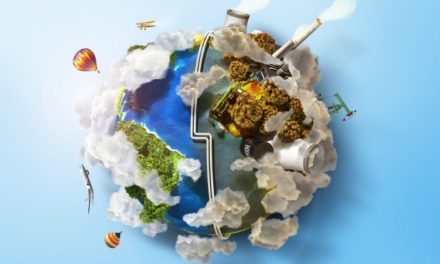The point of it all struck me particularly as I reflected on the hugely successful Partner Power Summit that was broadcast at the beginning of this month. The event was produced by the Trust for Sustainable Living and I was honoured to contribute a sponsorship. The summit brought together elementary and secondary students, teachers, scientists, the public, and United Nations leaders from across the globe in a week-long discussion to set the path to a sustainable and happy future.
Among the featured summit speakers was Gitanjali Rao, a brilliant and driven student who at the age of 13 invented a system that can inexpensively and effectively test for lead in water. Gitanjali discussed her invention in a TED Talk last year which cannot fail to motivate any adult or child watching it, and she spoke most eloquently on the last day of the Partner Power summit about engaging youth with science.
Not every child, of course, has the same level of imagination as Gitanjali does or is presented in life with the right circumstances and motivated by the right parents and teachers to achieve as much as she has at such an early age. But the fact that each child has undiluted potential, and that potential is sparked by curiosity and imagination, was clear to witness during the summit. What a wonderful world we could build, if we would provide every child with the opportunity for curiosity and imagination to flourish. Surely we would make a good account of ourselves, and an excellent account of time, if we nurtured the potential of children to the fullest extent.
Our every action and reaction adds to the account of time, most often in very small measures but sometimes in very significant ways. We can think of time’s account like a physicist’s wave function, a metaphor that Robert Kennedy affirmed most eloquently in his famous 1966 speech to students in apartheid South Africa (listen to it here, the philosophy soars particularly from minute 24:40): “It is from numberless diverse acts of courage and belief that human history is shaped each time a man stands up for an ideal or acts to improve the lot of others or strikes out against injustice. He sends forth a tiny ripple of hope, and crossing each other from a million different centers of energy and daring, those ripples build a current that can sweep down the mightiest wall of oppression and resistance.”
There is a particular account of time and ripple of hope that I am several months overdue in delivering with the first instalments of the story of Luca Pacioli, Leonardo da Vinci, and the geometry of time that I promised in my last blog. Blame the delay on the pandemic and the added time that remote working and helping clients to navigate the changing array of government support entailed, during the months of the heaviest of the annual year-end and tax deadline cycle. Such is the life of an accountant, and of this one in particular who is grateful to his staff and clients for their belief that made it possible to meet the challenges of these times together.
The story of Luca and Leonardo and their three-year collaboration from 1496-1499 is taking shape in a way that I hope will be plausible and entertaining in delivering an important message about the nature of time. Luca is the largely unsung inventor of the binary recording system that all accountants on earth (like me) have used for the past 5 centuries while Leonardo, of course, needs no introduction for his creative genius that has gripped the imaginations of generations in the 501 years that have passed since his death. It is a shame that accounting students are not taught about Luca’s history, and in particular about his ground-breaking observations on the golden ratio in his Divina Proportione, for which Leonardo provided 60 illustrations. We can see the combined genius of Luca and Leonardo here, and in rediscovering the system of Pacioli I have gained a deep appreciation for its monumentally complex mathematical and geometric requirements that have withstood the test of time.
It is easy to dismiss Luca’s system for its apparent mathematical ease – after all, debit and credit are always equal and opposite and always add up to zero. What does not, however, always add up to zero is equity, which accumulates in relative differentials of belief as belief is exchanged between buyer and seller. Debit and credit are fixed and invariable binary measures, while equity is nothing of the sort, and Luca and Leonardo’s work on the golden ratio provided a means to maintain equity in fluid variability as time progresses.
Time is, in a natural sense, what each one of us makes of it in our individual and collective capacity for belief, and this is why Pacioli chose two words – debit (meaning belief owed) and credit (meaning belief received) to account for every financial transaction in time. Money has no intrinsic value; money’s value is in the belief that buyer and seller place in it as a medium of their exchange.
Belief in ourselves, individually and collectively, and in time’s potential can become strained at certain points in history. Such points of strain are marked by one or combinations of conflict, fear, recession and depression, hyper-inflation, tribalization, alienation, acceleration of income inequality, racism, intentional distortions of knowledge, and other sources of unhappiness. Such strains have been increasing in recent times, in some cases globally and in other cases locally, often compounded by the abuses of technology and now also by the pandemic. But as devastating as the pandemic continues to be, particularly in areas where belief in responsibility to each other is not readily accepted, the virus has given people across the globe the occasion to reassess priorities and to understand that each one of us is part of a greater whole, and each of us is dependant on others to some measure throughout our lives. What goes around comes around, as the saying goes, and now is a time when humane technology that I wrote about in my last blog in support of people like Tristan Harris would be of such great service to humanity. And particularly so to a humanity about to unleash the potential of quantum computing.
This realization struck me particularly in the first few weeks of pandemic lockdown, on a necessary visit to the grocery store to replenish a depleted refrigerator and cupboards. Rich or poor, mighty or meek, leader or follower, we all need food to survive, and I was moved to say to the elderly cashier, “Thank you, we need you!” Yes, I can account and I can prepare tax returns, but I cannot grow, manufacture, and package food, nor can I make clothing or build homes or generate electricity or design computers or fulfill many of the other functions so necessary to life in a modern city. Living the way we do, we have a responsibility to each other regardless of class, gender, race, creed, or any of the other ways we differentiate ourselves, and this is what the pandemic has taught us. When we exercise that responsibility with care and shared belief in each other, the virus is held at bay; when we disregard the responsibility, the virus prevails as mutual belief frays.
Likewise, we have a responsibility to time and to make the most of time’s potential not only for ourselves as adults but especially for the children of the world who are dependant on us for the necessities of life and for the education and inspiration that will one day make them responsible citizens. It is to today’s children that we will pass the generational torch of command as we become old and begin to fray. We have this fiduciary responsibility to discharge, from moment to moment in the present, and the children of the world have a right to expect us to deliver on that responsibility. As we benefited from aspirations and hard work of our parents and forbears in our own upbringing, this is the legacy we received and must deliver to those who will follow us. The majority of the four score years statistically allotted to my own existence has already passed, and in the time that remains to me my commitment is to deliver a better world to the young and to the unborn generations who will follow. Let this be our individual and collective commitment.
The point of it all is the children, and the unborn generations to follow in the continuum of life. We, today’s adults, are the guardians of time and ours is a responsibility to protect and nourish time’s potential so the future will benefit as we now do, in the present, from the actions of the past. It requires all of us, working in concert as a society – some of us as accountants, others as grocery clerks or home builders or lawyers or farmhands or bankers or data scientists or philosophers or mathematicians and physicists and the teachers and doctors and nurses who take care of all of us and on the list goes to infinite potential – to lay the foundations for the Gitanjali Rao’s of this world to succeed and to make the future something worthy of our legacy.
This is the point of it all, that struck me with the summit that I was so pleased to help sponsor. Partner Power: the infinite potential when we work together is a full measure of infinity greater than the sum of the individual probabilities. Partnership is the path from the present to the future, and as I watched the summit I began to understand that the potential of time is very bright indeed.
IMAGE ATTRIBUTION
Free Explosion of a Star Stock Photo by Free Images User: Gavin Mills [https://www.freeimages.com/photo/explosion-of-a-star-1174743]





